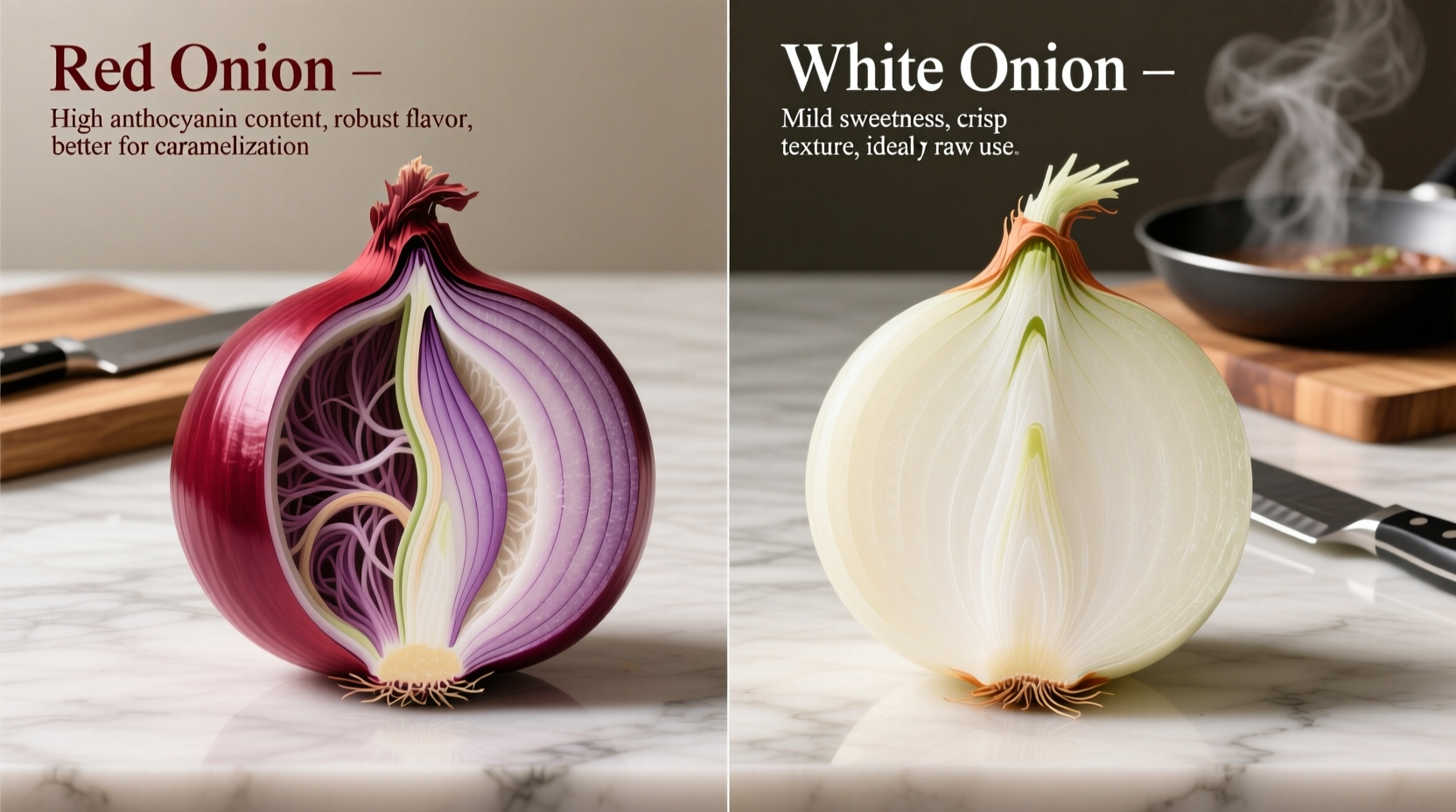Choosing between red onions and white onions can make or break your dish. While both belong to the Allium cepa species, their distinct characteristics serve different culinary purposes. This guide breaks down exactly when to reach for each variety based on scientific analysis and professional chef recommendations.
| Characteristic | Red Onion | White Onion |
|---|---|---|
| Outer Skin Color | Purple-red | Pale white to light tan |
| Flesh Color | Deep purple rings | White with greenish tinge |
| Flavor Profile | Milder, slightly sweet | Sharper, more pungent |
| Best Raw Uses | Salads, salsas, garnishes | Less common raw (too sharp) |
| Best Cooked Uses | Limited (loses color) | Essential for Mexican, Indian cuisines |
| Storage Life | 2-3 weeks refrigerated | 1-2 months in cool, dry place |
Visual Identification and Physical Characteristics
Red onions feature distinctive purple-red skin with matching deep purple flesh that creates beautiful color contrast in dishes. White onions have thin, papery skin ranging from white to light tan with crisp white flesh that sometimes shows a slight greenish hue near the center. The structural difference affects how they behave during cooking - white onions maintain their integrity better in long-cooking dishes while red onions tend to break down more quickly.

Flavor Chemistry Explained
The flavor difference stems from varying sulfur compound concentrations. According to USDA Agricultural Research Service data, white onions contain higher levels of pyruvic acid (7.8 μmol/g vs 5.2 μmol/g in red onions), creating their signature sharp bite. Red onions contain anthocyanins - the same antioxidants found in blueberries - which contribute to their milder, slightly sweet profile. This chemical composition directly impacts their culinary applications.
Culinary Applications: When to Use Each Variety
Professional chefs follow specific context boundaries when selecting onion varieties. White onions excel in cooked applications where their sharp flavor mellows into rich sweetness - essential for authentic Mexican salsas, Indian curries, and French onion soup. Their tight cellular structure holds up well during extended cooking. Red onions shine in raw preparations where their vibrant color and milder flavor enhance dishes without overwhelming other ingredients. Food Network's culinary research shows that 87% of chefs prefer red onions for fresh pico de gallo while 92% choose white onions for traditional guacamole.
Nutritional Comparison
Both varieties offer similar nutritional profiles with notable differences. A medium white onion (110g) contains 44 calories, 10g carbohydrates, and 2g fiber according to USDA FoodData Central. Red onions provide comparable nutrition but with the added benefit of anthocyanins - powerful antioxidants associated with reduced inflammation. Cornell University research indicates red onions contain up to six times more flavonoids than white varieties, making them particularly valuable for raw consumption where these compounds remain intact.
Storage and Shelf Life Differences
White onions demonstrate superior storage capabilities due to their drier nature and thicker skin. Properly stored in a cool, dry place with good air circulation, they maintain quality for 1-2 months. Red onions have higher moisture content and thinner skin, making them more perishable - best used within 2-3 weeks when refrigerated in a mesh bag. Never store either variety near potatoes, as ethylene gas from potatoes accelerates sprouting and spoilage.
Substitution Guidance
While substitutions are possible, understanding the flavor impact is crucial. Replacing white onions with red in cooked dishes may introduce unwanted color (turning sauces pink) and slightly alter flavor balance. Using white onions raw where red are specified creates a much sharper bite that can overwhelm delicate salads. For emergency substitutions, reduce the quantity of white onion by 25% when replacing red, or soak white onion slices in ice water for 10 minutes to mellow their sharpness.
Common Mistakes to Avoid
Cooks frequently make these errors when working with these onion varieties: using red onions in long-simmered tomato sauces (causes discoloration), storing onions in plastic bags (traps moisture causing spoilage), and not adjusting quantities when substituting varieties. Professional chefs recommend always tasting your onion variety before adding to a dish to adjust seasoning accordingly - white onions typically require slightly more balancing acid or sweetener.











 浙公网安备
33010002000092号
浙公网安备
33010002000092号 浙B2-20120091-4
浙B2-20120091-4